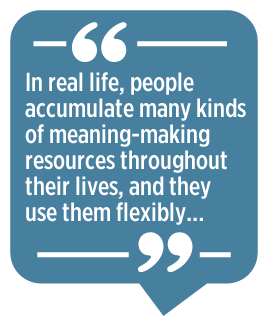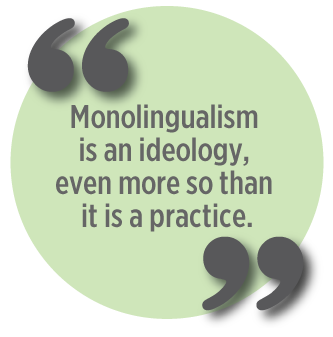|

Can I be an effective language teacher if
I’m monolingual? This question came up recently in a course full of preservice English for speakers of other languages (ESOL) teachers. Once asked,
it became clear that the question had been lurking on a number of people’s
minds. Some nervously expressed that they had felt afraid or too guilty about
their own monolingualism to pose the question sooner, especially in front of
multilingual peers.
In this
article, we suggest this is a critical question for all members of the TESOL
community to consider, whether they identify as monolingual or multilingual.
However, we argue that this is not just one question, but a line of questioning
that begins with what we mean by monolingual.
Exploring Monolingualism
From a
sociocultural perspective, monolingualism is an ideology, even more so than it
is a practice (de Jong, 2013). In the following sections, we elaborate on what
that means.
Language
Varieties
Every person
has multiple language varieties in their repertoire, as many language varieties
as the social contexts they’ve encountered in their life so far. People who
think of themselves as monolingual draw from different varieties in different
situations, just as multilingual people do. For example, one elementary teacher
candidate who identified as monolingual elaborated:
I took 3
years of Spanish classes in undergrad and used to practice it a lot when
traveling, but I consider myself to be monolingual because I don’t use Spanish
every day now. But I guess I don’t use academic English every day either. When
I’m at home with my dog, Roscoe, I use a sort of “talking to puppies” English.
And what I guess I would call a more “casual privileged” English with my
college friends. But that kind of casual is pretty different from the way I
talk with my grandma or even my parents even in casual settings.
Similarly, a
secondary teacher candidate expressed:
I too do not
know of any other language outside of English besides taking Spanish classes
all throughout high school. As someone who is monolingual, it can be scary to
walk into a classroom that is over half English learners…I speak enough Spanish
to communicate with students and parent(s) and/or guardian(s) but not teach
content.
Counter to
what the label “monolingual” implies, these teacher candidates list multiple
languages and language varieties they have in their meaning-making repertoires.
They also observe some of the different situations in which they draw on these
different resources. Despite identifying as monolingual, they do not describe a
mind that holds only a single language, or a mouth that uses only one language
variety. In real life, people accumulate many kinds of meaning-making resources
throughout their lives, and they use them flexibly to meet the needs of
whatever situations they find themselves in—which leads to the first dimension
of this issue: In practice, how monolingual are you?1
 Monolingual
Ideologies Monolingual
Ideologies
Monolingual
ideology, on the other hand, is a belief about language
use, as opposed to the language use itself. Monolingual ideology is what allows
one language, like so-called academic English, to become idealized as
“standard” even though we know people’s actual everyday language practices
involve multiple languages/varieties. Some of the ideas that underlie a
monolingual ideology are that
-
monolingualism is the norm
in any given society,
-
language standardization is
needed for effective communication, and
-
assimilation to the
standard language practices of a group is what allows a person to successfully
join that group.
From this
perspective, language diversity is a threat to ideals of efficiency and
oneness.
In an ESOL
classroom, monolingual ideologies might show up in teaching practices that
focus centrally on English with a lack of substantive attention to students’
home or community languages. These ideologies may also surface in teacher
comments about the need for students to share a common language with reference
only to English. Other examples include teacher comments about students needing
academic English for social mobility, with no attention to the ways other
languages/varieties afford people access to jobs.
Plural Language
Ideologies
In contrast,
plural language ideologies reflect a belief that language variation, mixing,
and hybridity are the norm for all language users. Diversity is seen as the
norm, not a problem to be overcome. From this perspective, no language variety
is inherently more logical or valuable than another. Instead, “standard
English” and “success” are seen as social constructs that are intertwined with
nonlinguistic structures like power, racism, and colonization.
In the ESOL
classroom, plural language ideologies might show up in moments where teachers
support students to make academic meanings using a variety of resources from their
meaning-making repertoires, thereby disrupting the privileging of “standard”
language use in school settings. Plural language ideologies might also be
reflected in assignments that value and affirm the variety in students’
language practices, such as identity texts (Cummins, Hu, Markus, &
Montero, 2015), or in comments to colleagues and students that position
language variety as a norm rather than a deficit (Accurso, Lopez Rodriguez,
& Lopez, 2019).

Some
teachers find themselves in between monolingual and plural language ideologies.
They believe bilingualism is beneficial, but that adding academic English is
what will lead students to success in the dominating culture. They may see this
as a pragmatic stance to take in contexts where English is the official
language, whether this is an explicit or simply de facto policy.
Mono- and Plural Language Ideologies in Practice
Importantly,
these language ideologies do not necessarily correspond
with the way a teacher identifies, and they are not fixed. Monolingual
ideologies are something that anyone, whether they identify as monolingual or
multilingual, can have and display and teach from at any given time, even if
they generally ascribe to more plural language ideologies. For some language
teachers, this can be difficult to comprehend, a “mind warp” as one teacher
candidate put it. “You mean I can be ‘monolingual’ but not have monolingual
beliefs?! And sometimes I might be teaching in ways that show monolingual
beliefs even if I really believe different languages are all valuable?” Yes,
which leads to a second dimension of this issue: To what extent have monolingual
beliefs influenced you as a teacher?
Matthew, a
secondary teacher candidate, observed:
Most
American public school teachers probably do not know what it is like to be in a
situation in which they are unable to communicate with their classmates or
teachers. That means I need to work harder to relate to my students,
differentiate their education, and create an inclusive, open-minded learning
environment.
In this
quote, Matthew also points to a third dimension of this issue: pedagogy. In
other words, how “monolingual” a teacher’s approach to language teaching is.
Readers, how do you involve different varieties of language in your classroom?
What beliefs about language do you act out when you create and describe
assignments? What about when you model “exemplary” language for a particular
content area? When you react to students’ language use?
Developing Plural Language
Ideologies and Practices
Research has
shown that monolingual ideologies can hamper good teaching, and cause academic,
emotional, social, and economic harm for ESOL students (e.g., de los Rios
& Seltzer, 2017). Therefore, we advocate for a move away from
“monolingual” understandings of people and pedagogy. Instead, our suggestion is
that as a TESOL community we each develop a more nuanced view of our language
practices and varieties and reflect on our language ideologies and the ways we
see different ones showing themselves in our teaching and in the broader
society.
To that end,
we conclude with a Language Ideology
Guide for Reflection and Action (Appendix). Readers (whether
preservice teachers, in-service teachers, or teacher educators) can use the
guide to notice different language ideologies at play in their lives inside and
outside of school. In addition, the guide provides practical, actionable
suggestions for moving toward more plural language ideologies and teaching
practices. Over time, we hope this guide will support readers in moving away
from perceptions of linguistic inadequacy—their own or their students’—because
as language and literacy scholars Paris and Alim (2017, p. 6) remind us, “the
future is a multilingual one.”
1We recognize that this
is an extremely simplified account of languaging, and we don’t mean to imply
that there is no difference between meaning-making repertoires with many
official languages in them, and repertoires who have only grown to include
varieties of a single named language. We mainly mean to question and complicate
readers’ understanding of what is meant by monolingual.
References
Accurso, K.,
Lopez Rodriguez, S., & Lopez, A. (2019). Challenging deficit
perspectives of multilingual learners in everyday talk. MATSOL
Currents, 42(1), 39–42.
Cummins, J.,
Hu, S., Markus, P., & Montero, M. K. (2015). Identity texts and
academic achievement: Connecting the dots in multilingual school contexts. TESOL Quarterly, 49,
555–581.
de Jong, E.
(2013). Toward a monolingual USA? The modern English-only movement. Colorín Colorado. https://www.colorincolorado.org/article/toward-monolingual-usa-modern-english-only-movement
de los Ríos,
C. V., & Seltzer, K. (2017). Translanguaging, coloniality, and English
classrooms: An exploration of two bicoastal urban classrooms. Research in the Teaching of English, 52(1), 55–76.
Paris, D., & Alim, H. S.
(Eds.). (2017). Culturally sustaining pedagogies: Teaching and learning
for justice in a changing world. Teachers College Press.
Dr. Kathryn
Accurso is an assistant professor of
teaching in language and literacy education at the University of British
Columbia in Vancouver. As an applied linguist and former English teacher, her
research and teaching focus on the relationship between literacy, equity, and
teacher education. Her main area of leadership is exploring how to best prepare
Pre-K–12 teachers to effectively and responsibly teach culturally and
linguistically diverse students in the face of structural
inequities.
Dr. Brenda
Muzeta is an assistant professor in
secondary education at Kutztown University. Dr. Muzeta holds a PhD in teacher
education and curriculum studies from the University of Massachusetts, Amherst.
She takes a broad interest in issues pertaining to language, culture, identity,
social justice, and equity in education. Her research draws on the voices and
experiences of English learners to better understand the sociocultural and
sociopolitical contexts in which these students develop and grow. |